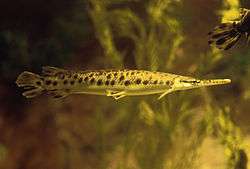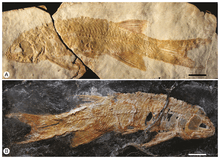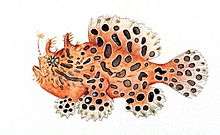Holostei
Holostei is a group of bony fish including gars (with 7 extant species) and bowfins (with 1 extant species). There are eight species divided among two orders: the Amiiformes, represented by a single living species, the bowfin (Amia calva); and the Lepisosteiformes, represented by seven living species in two genera, the gars. Further species are to be found in the fossil record and the group was thought to be regarded as paraphyletic. However, a recent study proves that the Holostei is a sister group of the Teleostei, both within the Neopterygii. This was found from the morphology of the Holostei, for example presence of a paired vomer.[1] Holosteans are closer to teleosts than are the chondrosteans, the other group intermediate between teleosts and cartilaginous fish, which are regarded as (at the nearest[lower-alpha 1]) a sister group to the Neopterigii. The spiracles are reduced to vestigial remnants and the bones are lightly ossified. The thick ganoid scales of the gars are more primitive than those of the bowfin.
| Holostei | |
|---|---|
 | |
| Spotted gar, Lepisosteus oculatus | |
 | |
| Bowfin, Amia calva | |
| Scientific classification | |
| Kingdom: | Animalia |
| Phylum: | Chordata |
| Class: | Actinopterygii |
| Subclass: | Neopterygii |
| Infraclass: | Holostei |
| Orders | |
Characteristics
Holosteans share with other non-teleost ray-finned fish a mixture of characteristics of teleosts and sharks. In comparison with the other group of non-teleost ray-finned fish, the chondrosteans, the hholosteans are closer to the teleosts and further from sharks: the pair of spiracles found in sharks and chondrosteans is reduced in holosteans to a remnant structure: in gars, the spiracles do not even open to the outside;[2] the skeleton is lightly ossified: a thin layer of bone covers a mostly cartilaginous skeleton in the bowfins. In gars, the tail is still heterocercal but less so than in the chondrosteans. Bowfins have many-rayed dorsal fins and can breathe air like the bichirs.
The gars have thick ganoid scales typical of sturgeons whereas the bowfin has thin bony scales like the teleosts. The gars are therefore in this regard considered more primitive than the bowfin.[3]
The name Holostei derives from the Greek, holos meaning whole and osteon meaning bone: a reference to their bony skeletons.
Orders
Holostei consists of two orders, Lepisosteiformes and Amiiformes. Lepisosteiformes includes 1 family, 2 genera, and 7 species that are commonly referred to as gars. Amiiformes includes 1 family, 1 genus, and only 1 species that are commonly referred to as bowfins. In the cladogram below you can see Holostei branching off from the common ancestor Neopterygii with Teleostei. Gars and bowfins are found in North America and in freshwater ecosystems. The differences in each can be spotted very easily from just looking at the fishes. The gars have elongated jaws with fanlike teeth, only 3 branchiostegal rays, and a small dorsal fin. Meanwhile the bowfins have a terminal mouth, 10-13 flattened branchiostegal rays, and a long dorsal fin.
Phylogeny
The cladogram shows the relationships of holosteans to other bony fish, the great majority of which are teleosts,[5] and to the terrestrial vertebrates (tetrapods) that evolved from a related group of fish.[6][7] Approximate dates are from Near et al., 2012.[5]
| Osteichthyes |
| ||||||||||||||||||||||||||||||||||||||||||||||||||||||
Notes
- Depending who you ask, the Chondrostei may be paraphyletic, or the Polypteridae may be considered not part of them.
- Thus the former "Chondrostei" is not a clade, but is broken up. See Actinopteri for a possible reclassification.
References
- Hastings, Walker Jr., Galland (2014). FISHES, A GUIDE TO THEIR DIVERSITY. Oakland, California: University of California Press. pp. 60–62.CS1 maint: multiple names: authors list (link)
- Ontario. Game and fish commission
- Rick Leah. "Holostei". University of Liverpool (http://www.liv.ac.uk).
- Brito, Paulo M.; Alvarado-Ortega, Jesus (2013). "Cipactlichthys scutatus, gen. nov., sp. nov. a New Halecomorph (Neopterygii, Holostei) from the Lower Cretaceous Tlayua Formation of Mexico". PLoS ONE. 8 (9): e73551. doi:10.1371/journal.pone.0073551. PMC 3762789. PMID 24023885.
- Thomas J. Near; et al. (2012). "Resolution of ray-finned fish phylogeny and timing of diversification". PNAS. 109 (34): 13698–13703. doi:10.1073/pnas.1206625109. PMC 3427055. PMID 22869754.
- Betancur-R, Ricardo; et al. (2013). "The Tree of Life and a New Classification of Bony Fishes". PLOS Currents Tree of Life. 5 (Edition 1). doi:10.1371/currents.tol.53ba26640df0ccaee75bb165c8c26288. PMC 3644299. PMID 23653398. Archived from the original on 2013-10-13.
- Laurin, M.; Reisz, R.R. (1995). "A reevaluation of early amniote phylogeny". Zoological Journal of the Linnean Society. 113 (2): 165–223. doi:10.1111/j.1096-3642.1995.tb00932.x.

